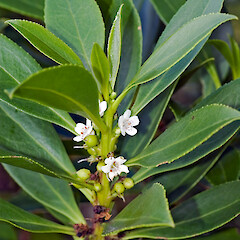Myoporum aff. insulare
Common name
Tasmanian ngaio, boobialla
Family
Scrophulariaceae
Flora category
Vascular – Exotic
Structural class
Trees & Shrubs - Dicotyledons
Conservation status
Not applicable
Habitat
Terrestrial. Coastal areas, sandy sites behind beaches.
New Zealand plants are male sterile and do not match M. insulare s.s. but rather an apparently unnamed species from Victoria. All wild occurrences referred to M. insulare appear to be hybrids between this entity and M. laetum, with which M. aff. insulare plants cross readily. The reverse appears to be the case in Victoria, where M. laetum has been planted.
Detailed description
Large shrub or small tree with numerous branches from base, generally with dense bushy habit. Bark smooth. Leaf buds green and more or less viscid when fresh, often drying black. Petiole c. 1 cm long, scarcely distinct from attenuate base of lamina. Lamina 4-12 X 1.25-3 cm, elliptic or narrowly elliptic, thick and semi-succulent, finely dotted with pellucid glands, mostly serrulate in the upper 1/2, occasionally entire or, especially in juvenile leaves, more extensively serrulate or serrate; apex mostly acute. Fls 1-few; pedicels c. 5 mm long at anthesis. Calyx c. 3 mm long, lobed nearly to base; lobes lanceolate-acuminate. Carolla 7-8 mm diam.; lobes>tube, rounded, white with fine purple dots, white-bearded inside towards base. Style hairy. Drupe c. 6 mm diam., broad-oblong or broad-ovoid (almos as wide as long), shining deep purple. (Webb et al 1988).
Similar taxa
Can be distinguished from ngaio (Myoporum laetum) by the leaf buds which are light green, not especially resinous, flowers less than 10 mm wide and fruit which are deep purple and almost as wide as long. M. laetum has resinous, dark purple or black leaf buds, flowers 10 -15 mm wide, and oblong fruit usually mauve to purple or reddish purple, occasionally white.
Flowering
September, October, November, December, January, February, March, April, May, June
Flower colours
Violet/Purple, White
Life cycle
Perennial.
Year naturalised
1978
Origin
Temperate Australia, Lord Howe Island.
Reason for introduction
Horticultural. Myoporum aff. insulare as M. serrulatum, based on Royal Horticultural Society of New Zealand records was supposedly introduced as a garden plant to New Zealand in the 1950s. However, it seems that Governor George Grey received plants from Melbourne based botanist Ferdinand von Mueller (these came from East Gippsland) and planted these on Kawau Island in 1870. Flora IV (Webb et al. 1988) records this taxon, as M. insulare, as having first naturalised in 1978 - this is unlikely, the date of “first” naturalisation was probably much earlier but that record is most likely based on the first genuinely wild occurrence the authors of that flora could find in New Zealand herbaria. The authors of Flora IV quite understandably, had to apply a ruling on what constituted a “first naturalisation” so their system, based on undisputed herbarium specimens of wild plants does not necessarily mean that the date cited was the first time a particular species had started to naturalise.
Etymology
myoporum: Shut pore
insulare: From the Latin insula ‘island’, pertaining to or growing on islands
National Pest Plant Accord species
This plant is listed in the 2020 National Pest Plant Accord. The National Pest Plant Accord (NPPA) is an agreement to prevent the sale and/or distribution of specified pest plants where either formal or casual horticultural trade is the most significant way of spreading the plant in New Zealand. For up to date information and an electronic copy of the 2020 Pest Plant Accord manual (including plant information and images) visit the MPI website.
Poisonous plant
This species, with purple berries, is very poisonous.
Attribution
Fact Sheet prepared for the NZPCN by: P.J. de Lange (1 February 2006).
NZPCN Fact Sheet citation
Please cite as: de Lange, P.J. (Year at time of access): Myoporum aff. insulare Fact Sheet (content continuously updated). New Zealand Plant Conservation Network. https://www.nzpcn.org.nz/flora/species/myoporum-aff-insulare/ (Date website was queried)





